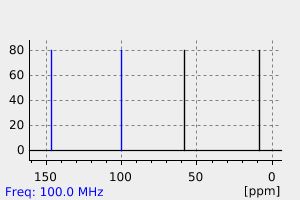(Z)-1-甲氧基丙-1-烯 | 4188-68-5
中文名称
(Z)-1-甲氧基丙-1-烯
中文别名
——
英文名称
methyl (Z)-prop-1-enyl ether
英文别名
methyl prop-1-enyl ether;1-methoxypropene;methoxypropene;1c-methoxy-propene;methyl-cis-propenyl ether;Methyl-cis-propenyl-aether;methyl (1-propenyl) ether;methyl propenyl ether;cis-1-Propylmethyl ether;(Z)-1-methoxyprop-1-ene
CAS
4188-68-5
化学式
C4H8O
mdl
——
分子量
72.1069
InChiKey
QHMVQKOXILNZQR-ARJAWSKDSA-N
BEILSTEIN
——
EINECS
——
-
物化性质
-
计算性质
-
ADMET
-
安全信息
-
SDS
-
制备方法与用途
-
上下游信息
-
文献信息
-
表征谱图
-
同类化合物
-
相关功能分类
-
相关结构分类
计算性质
-
辛醇/水分配系数(LogP):1.1
-
重原子数:5
-
可旋转键数:1
-
环数:0.0
-
sp3杂化的碳原子比例:0.5
-
拓扑面积:9.2
-
氢给体数:0
-
氢受体数:1
安全信息
-
海关编码:2909199090
SDS
反应信息
-
作为反应物:描述:参考文献:名称:异构烷基烯丙基和烷基(Z)-丙烯基醚的相对热力学稳定性摘要:十种烯丙基醚(ROCH 2 CH = CH 2)和相应的异构体(Z)-丙烯基醚(其中R为烷基或甲氧基取代的烷基)的相对热力学稳定性已通过DMSO溶液中的化学平衡确定。以t- BuOK为催化剂。从平衡常数随温度的变化,评估了在298.15 K下异构化的热力学参数ΔGΘ,ΔHΘ和ΔSΘ的值。丙烯醚在平衡时非常受青睐,烯丙基→丙烯基反应的ΔGΘ和ΔHΘ均为ca。-18至-25 kJ mol -1。庞大的烷基取代基增加了丙烯基醚的支持,而甲氧基取代的烷基则减少了丙烯基醚的支持。在大多数情况下,熵的贡献可以忽略不计。然而,对于R =(MeO)2 CH和R =(MeO)3 C,ΔSΘ的值约为。-5 JK -1 mol -1。DOI:10.1016/s0040-4020(01)81820-2
-
作为产物:描述:参考文献:名称:四氢呋喃中的二异丙基氨基钠:烯烃的异构化和二烯金属化的选择性,速率和机理摘要:四氢呋喃中的二异丙基酰胺钠是1,4-二烯金属化和烯烃异构化的有效碱。二烯通过四溶剂化钠酰胺单体金属化,而1-戊烯则被三溶剂化单体异构化。在与现有方案相比有利的条件下,观察到烯丙基醚的容易的,高度Z-选择性的异构化。选择性与烯丙基醚上的取代基无关;速率和计算数据表明,钠-氧接触的速率,机理和作用是取代基依赖性的。讨论了底物配位和溶剂配位对钠的竞争影响。DOI:10.1021/jacs.7b05218
文献信息
-
Cycloaddition of cyclic vinyl ethers to an isoquinolinium salt: application to the preparation of a model C-naphtylgycoside
-
1,2-Bis(trifluoromethyl)ethene-1,2-dicarbonitrile: Enol Ethers and Ketene Acetals as Cycloaddition Partners作者:Rolf Huisgen、Gonzalo Urrutia DesmaisonDOI:10.1002/hlca.201200217日期:2012.719F‐NMR data served the structural assignment and the quantitative analysis. The mechanistic discussion is based on rotations and ring closures of the assumed 1,4‐zwitterionic intermediates. Dimethylketene dimethyl acetal, methylketene dimethyl acetal, and ketene diethyl acetal show an increasing rate in their reactions with BTE as well as in the equilibration of the cycloadducts.
-
Reaction of vinyl- and propenyl-ethers with tert-butoxyl radicals - an ESR study作者:Hans-Gert Korth、Reiner SustmannDOI:10.1016/s0040-4039(00)98834-8日期:1985.1Photolytically generated tert-butoxyl radicals react with vinyl- and propenyl ethers by hydrogen abstraction and addition to the double bond; the abstraction/addition ratio and the regioselectivity of addition are interpreted in terms of predominant steric interactions.
-
Reactions of allylic compounds such as allyl alcohols, allyl ethers, and allylamines using trans-Mo(N2)2(Ph2PCH2CH2PPh2)2作者:T. Tatsumi、K. Hashimoto、H. Tominaga、Y. Mizuta、K. Hata、M. Hidai、Y. UchidaDOI:10.1016/0022-328x(83)80062-x日期:1983.8Double-bond migration of allylic alcohols and allylic alkyl ethers was catalytically effected with trans-Mo(N2)2(dpe)2(dpe = Ph2PCH2CH2PPh2). Decarbonylation occurred simultaneously in the case of allyl alcohol. Diallyl ether and allyl phenol ether gave the fragmentation products presumably through initial oxidative addition of the allylO bond. Allylamine was converted to N-propylideneallylamine and
-
Pyrolytic elimination of acetates作者:C.H. DePuy、R.W. King、D.H. FroemsdorfDOI:10.1016/0040-4020(59)80059-4日期:——of 1-methylcyclohexyl acetate-2,2,6,6-d4, the deuterium isotope effect for the acetate pyrolysis reaction has been determined to be 1·7 at 500° and 1·9 at 400°. These values are to be compared with the theoretical maximum values of 2·1 and 2·3 respectively. By carrying out competitive pyrolyses it has been possible to determine some relative rates of pyrolysis which show that no appreciable positive
表征谱图
-
氢谱1HNMR
-
质谱MS
-
碳谱13CNMR
-
红外IR
-
拉曼Raman
-
峰位数据
-
峰位匹配
-
表征信息
同类化合物
(反式)-4-壬烯醛
(s)-2,3-二羟基丙酸甲酯
([1-(甲氧基甲基)-1H-1,2,4-三唑-5-基](苯基)甲酮)
(Z)-4-辛烯醛
(S)-氨基甲酸酯β-D-O-葡糖醛酸
(S)-3-(((2,2-二氟-1-羟基-7-(甲基磺酰基)-2,3-二氢-1H-茚满-4-基)氧基)-5-氟苄腈
(R)-氨基甲酸酯β-D-O-葡糖醛酸
(5,5-二甲基-2-(哌啶-2-基)环己烷-1,3-二酮)
(2,5-二氟苯基)-4-哌啶基-甲酮
龙胆苦苷
龙胆二糖甲乙酮氰醇(P)
龙胆二糖丙酮氰醇(P)
龙胆三糖
龙涎酮
齐罗硅酮
齐留通beta-D-葡糖苷酸
鼠李糖
黑芥子苷单钾盐
黑海棉酸钠盐
黑木金合欢素
黑曲霉三糖
黑介子苷
黄尿酸8-O-葡糖苷
麻西那霉素II
麦迪霉素
麦芽糖脎
麦芽糖基海藻糖
麦芽糖1-磷酸酯
麦芽糖
麦芽四糖醇
麦芽四糖
麦芽十糖
麦芽六糖
麦芽五糖水合物
麦芽五糖
麦芽五糖
麦芽五糖
麦芽三糖醇
麦芽三糖
麦芽三糖
麦芽三塘水合
麦芽七糖水合物
麦芽七糖
麦法朵
麦可酚酸-酰基-Β-D-葡糖苷酸
麦利查咪
麝香酮
鹤草酚
鸢尾酚酮 3-C-beta-D-吡喃葡萄糖苷
鸡矢藤苷







